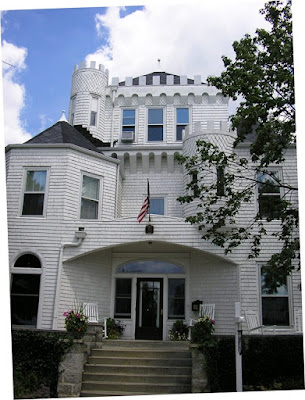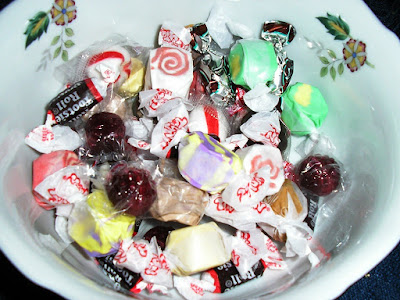This year is the centennial of the founding of the town of Winona Lake. It existed as a flourishing Chautauqua-type summer gathering place hosting thousands of seasonal visitors before that, but 1913 is the year it became incorporated. It has had its booms and busts, but currently puts itself forth as a destination spot for shopping and dining in the restored village by the lake and canal leading out to the lake on both ends. The Village at Winona has some interesting artisan shops (art gallery, beading, specialized soap and body lotions, spice and tea shop, weaving shop, olive oil shop, home décor, pottery shop) and several restaurants and a bakery.
The bakery serves sandwiches and pizzas besides pastries, muffins, breads, flavored coffees, and the famous Hoosier Mama cookies. It sits on the main road through the village, Park Avenue.
Across the corner is Kelaineys which also serves light meals and specialty drinks, but is best known for its ice cream. During Masterworks Festival in June and July, it is humming with pre-concert and post-concert customers, including many of the musicians.
Cerulean is a fun restaurant. At lunch, you select an entrée and 3 sides which are served in an Oriental bento box. The Asian-influenced food has nice sauces. There are sushi choices, too. Local products like duck (our county is a big supplier of duck), honey, etc. add flavor, too. Even if you don’t like Japanese or Chinese food, you will find items on the menu to your liking.
The Boathouse sits right next to the lake and is popular for lunch and dinner, especially on nice days when sitting in the screened-in porch suspended over the water is pleasant. It has a gift shop within.
Many of the businesses are located in historic houses moved from nearby areas. However, some of the housing are original structures. Last weekend there was an open-house tour of many of these. A fire that swept through the summer cottages in 1914, but a few buildings survived as well as those further away from the village’s entry point.
Felsenheim (“house of stone”) built in 1910 at Chestnut and 4th Street was one of the survivors. The window frames and other wooden trim were charred, but the house was intact. I stayed on the third floor of this house back in 1976 when it had been divided into many “apartments”. My friend Carol who was a seminary student let me stay with her for two nights until my little apartment at Lamp Post Manor was ready. What I remember most are the bats which Carol hit with a tennis racket, dazing them long enough to get rid of them. The whole house has been lovingly restored into an individual residence, and the third floor now dazzles.
Another building with which I have past associations is the Winona Hotel. It is the oldest building in the village, having been built in 1888 as the Eagle Lake Hotel (the lake also has changed names). In 1975-1976, I lived on a wing of the second floor being used as a dormitory for Grace College female students. My room had a great view of the lake. I was not a college student, but worked part-time in the college library while taking some seminary courses. Instead of a paycheck, I received free lodging and a meal card for the dining commons. About a decade ago, the hotel was purchased by private investors who converted it to luxury condominiums. I recognized on the tour the original staircase (there is now also an elevator) and what was for me a laundry for the dorm residents but now is just a little alcove.
I had seen the Terrace Drive buildings restored when I would visit family after moving to Texas. These buildings were built 1898 thru 1902 and were not endangered by the fire which swept up the hill to the west.
The Hillside served as a boarding house for many years during Winona’s “Golden Age” 1904-1914. During this era as many as 250,000 people came to the educational and cultural events during the summer. Distinguished speakers and musicians throughout the world provided the programming. One popular speaker, the evangelist Billy Sunday, decided to build a home in Winona Lake. Mount Hood was completed in 1911. It was part of the open-house tour; I had been in it decades ago, and it remains pretty much the same as it was when the Sunday family lived there, at least the way it was prior to his death. The Hillside was owned for awhile by Homer Rodeheaver, the music director for Sunday’s evangelistic campaigns. Virgil Brock, composer of Beyond the Sunset, a popular Christian song, also owned this house for awhile; since the house has a wonderful view of the lake’s sunset, it is not hard to see how he would be inspired.
Though not on the house tour, the Beyer home remains a prominent landmark of Winona Lake.
The Beyer brothers bought the tract of land around the lake in 1881 because its natural springs could be used to store the milk, butter, cream, and eggs of their dairy business. In 1887 they decided to develop the area into Spring Fountain Park, a place where families could stroll and enjoy the lake. There was eventually even a roller coaster and a golf course. The Beyers were the ones to build the hotel to house the guests that started pouring in. They prospered, and in 1907 two of the brothers decided to construct a mansion that was symmetrical, each of them occupying one side with their families. It had electrical wiring and outlets which was considered quite modern. This building has housed Grace College students and summer workers for the Christian Assembly during some down times for the community. It was restored by a historical restoration group, then sold in 2012 to become a private residence. In the photo you can see some benches. These are part of the Hillside Amphitheatre which has existed in some form since 1910. It faces the lake.
Rodeheaver built a grand home on Rainbow Point and hosted well-known national figures such as J. Edgar Hoover, Billy Graham, Will Rogers at dinners and lawn parties that hosted 200 people. Today, this structure stands but is surrounded by newer construction. You can see a portion of the home (the white building on the left). The idea was to make the house look like a great ship.
Many interesting buildings from Winona Lake’s heyday still function in the community: Mount Memorial, Westminster Hotel, Rodeheaver Auditorium. Most of them are currently owned by Grace Schools, but community events take place there. The Westminster houses an historical museum, the Reneker.
An eccentric home built in 1902, Killarney Castle still graces the island created by the canal.
The housing stock is often cottage-like and the way you would expect a lake resort town to appear, though most of the residents are now here year-long. The town still has run-down areas though; I don’t want to mislead. Out in the perimeter are newer subdivisions with golf courses. There is a nice playground park and Senior Center along the lake beach. The town has developed the property once known as the Chicago Boys Club campground into mountain bike trails, and there is a paved walking/biking path that meanders through the forest. It abuts Warsaw, a larger town known as a leader in the orthopedic industry. Grace College and Seminary plays a big role in Winona Lake. Grace Village, while not in the town shopping/dining area, also is a big part of the community. Come visit us sometime and see for yourselves.




























